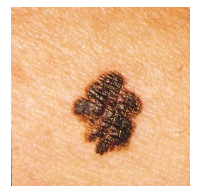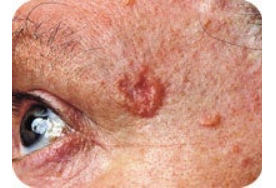By: Thalia Kaylyn Averil
Skin cancer is the most common type of cancer and can be treated more easily if detected early. Routine skin examinations can be carried out by healthcare professionals during general examinations or by the patient by examining the skin in front of a mirror once a month. Skin cancer is characterized by the growth of abnormal skin cells, often caused by exposure to UV rays. Normally, skin cells age and are replaced by new skin cells, but this process can occur more rapidly with skin cancer. These cells can be malignant or benign, so if cancer is not detected and treated, it has the potential to spread quickly to other parts of the body. The most common types of skin cancer are melanoma, basal cell carcinoma, and squamous cell carcinoma. In general, skin cancer develops in areas of the body that are frequently exposed to sunlight, such as the face, head and neck. However, it does not rule out the possibility that skin cancer can grow in all areas of the body.
MELANOMA

Melanocytes are melanin-producing cells which are responsible for providing color to the skin and protection from UV rays. Melanocytes are the source of melanoma, a dangerous skin cancer that can spread to other parts of the body. In general, melanoma occurs in individuals aged 60 years, but can also occur under 45 years. Melanoma is often found on the back in men, while melanoma is found on the lower legs and trunk in women. However, melanoma can appear anywhere that has melanocytes. Exposure to UV rays can cause mutations in genes, thereby damaging DNA. If DNA repair is not effective, gene mutations can accumulate in melanocytes and cause melanoma.
Apply “ABCDE” to identify some typical signs of melanoma.
- Asymmetry: The lesion (can be a mole or birthmark) has two different parts and is not identical to each other.

- Border: Lesions have irregular, uneven, unclear, curved, jagged borders.

- Diameter: The size of the lesion is more than 5 mm or as the same size as the eraser, but melanoma can also be smaller than 5 mm.
- Evolution: Changes in the size, shape, or color of a lesion over time.

BASAL CELL CARCINOMA

Basal cell carcinoma originates from basal cells that are located at the bottom of the epidermis (the outermost layer of the skin). Basal cell carcinoma is one of the most common types of cancer in humans. Basal cell carcinoma is primarily caused by exposure to UV rays and is often associated with genetic mutations. Although it can cause significant local damage to the skin, basal cell carcinoma rarely spreads to other parts of the body.
Here are some key things to identify for basal cell carcinoma.
- Lesions that are shaped like scars and are flat, hard, and pale or yellow in color.
- The raised area is reddish purple in color which may feel itchy.
- Small red or pink bumps that look like pearls with the characteristics of being translucent, shiny, and there are areas that are blue, brown, or black.
- A pink skin growth with edges that are higher than the center and may contain abnormal blood vessels.
- Open sores (may crust or ooze) that never heal or once heal, but then come back.
SQUAMOUS CELL CARCINOMA

Squamous cell carcinoma originates from squamous cells which can be found in the outer layer of the skin. This is caused by exposure to sunlight which damages DNA, causing rapid growth of skin cells called keratinocytes. Squamous cell carcinoma is the second most common skin cancer in individuals with normal immune systems and most common in individuals who are immunosuppressed.
Here are some key things to identify for squamous cell carcinoma.
- Red areas that are rough and scaly and may crust or bleed.
- The lump sometimes has a lower area in the middle
- Open sores (may crust or ooze) that never heal or once heal, but then come back.
- Wart-like lesions
However, not all skin cancers have the same appearance as described above. Consult a dermatologist about anything abnormal on your skin.
- Lesions (which can include redness, swelling, etc.) that have just appeared.
- Lesions that don’t look like other lesions.
- Wounds that never heal.
- Spread of color to surrounding skin.
- An itchy or painful area that never goes away or once goes away, but then comes back.
- Changes in the surface of the mole, such as becoming scaly, bleeding, oozing.
Skin cancer prevention can be done by limiting exposure to UV rays, especially in children and adolescents. Exposure to UV rays can be limited by using a high SPF sunscreen that includes broad protection against UVA and UVB rays or wearing clothing that covers the skin. Self-awareness of the early signs of skin cancer and regular skin checks can help prevent skin cancer.
Resources
- Kang S, Amagai M, Bruckner AL, Enk AH, Margolis DJ, McMichael AJ, et al. Fitzpatrick’s dermatology. 9th ed. New York City: McGraw Hill Education; 2019.
- American Cancer Society. How to spot skin cancer [Internet]. Georgia: American Cancer Society; 2020 Apr 8 [cited 2024 Jun 23]. Available from: https://www.cancer.org/cancer/latest-news/how-to-spot-skin-cancer.html
- Cancer council. Check for signs of skin cancer [Internet]. Sydney: Cancer council; date of publication unknown [cited 2024 Jun 23]. Available from: https://www.cancer.org.au/cancer-information/causes-and-prevention/sun-safety/check-for-signs-of-skin-cancer
- Cleveland Clinic. Skin cancer [Internet]. Cleveland: Cleveland Clinic; date of publication unknown [reviewed 2021 Nov 19] [cited 2024 Jun 23]. Available from: https://my.clevelandclinic.org/health/diseases/15818-skin-cancer
